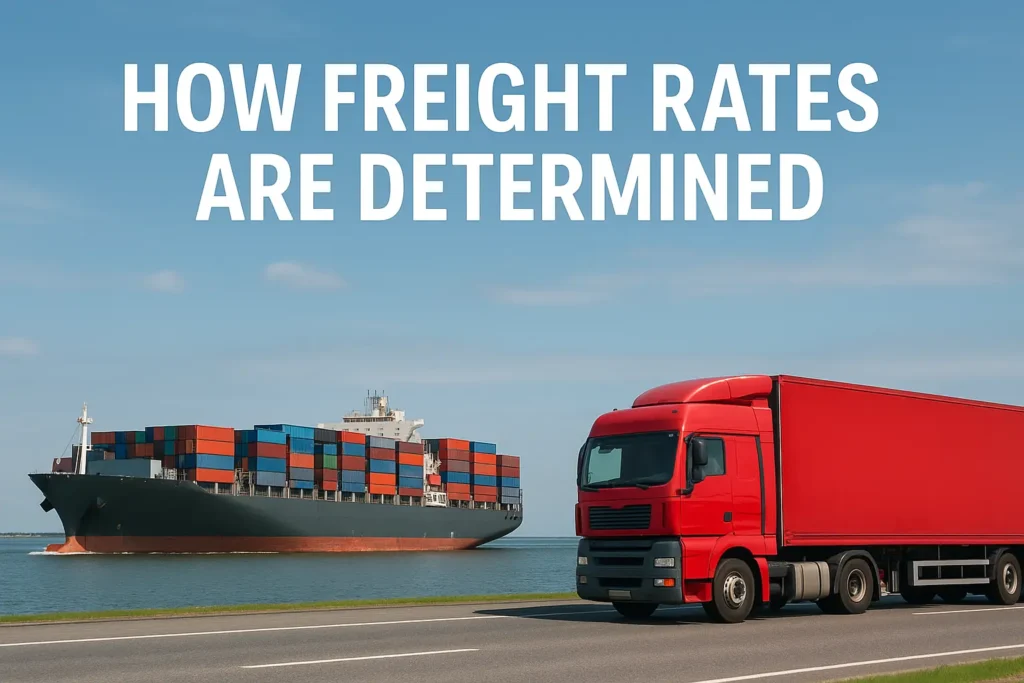If you have ever ordered something from abroad or shipped a product to another country, you might have wondered why shipping prices change so much. One month, freight rates are low. Next month, they go up suddenly. Why does that happen?
Freight rates are the prices charged to move goods from one place to another. They can be for ocean shipping, air freight, rail transport, or trucking. Understanding how these rates are set can help businesses plan better, avoid surprise costs, and make smarter decisions.
In this guide, we will break down the key factors that help decide freight rates in a simple and clear way.
1. Distance and Destination
The farther the distance, the higher the cost. Sending a container from Pakistan to Dubai will cost less than sending it from Pakistan to the United States.
Also, some destinations are more expensive because:
They are far away.
Fewer ships or planes go there.
The route may involve extra handling or security checks.
Example: Shipping a car from Karachi to Jeddah is usually cheaper than shipping it to the USA because it is a shorter route and has more frequent trips.
2. Mode of Transport
There are four main ways to move goods, and each has a different cost:
Choosing the right method depends on budget, time, and type of goods. For example, electronics or medical supplies often go by air because they need fast delivery.
3. Weight and Volume of Goods
Freight companies look at weight and space the shipment takes. Sometimes light items cost more because they take a lot of space.
This is called volumetric weight.
Example:
A shipment of cotton takes more space but weighs less.
A shipment of steel weighs more but may take less space.
Both can cost differently depending on how much room they occupy.
4. Type of Cargo
Not all goods are the same. Some require special handling or storage, which increases the rate.
Examples of special cargo:
Refrigerated goods (meat, fruits, medicines)
Dangerous goods (chemicals, batteries, fuel)
Oversized machinery
Fragile items like glass or electronics
The more care needed, the higher the price.
5. Fuel Prices
Fuel is one of the biggest costs in transportation. When fuel becomes expensive, freight rates also increase.
This is true for:
Ships
Trucks
Airplanes
Trains
Fuel price changes happen often due to global oil markets, so freight rates can change fast too.
6. Demand and Supply
Shipping works like a market—when demand is high and there are fewer vessels or trucks available, prices go up.
For example:
During holidays like Eid or Christmas, shipping demand increases.
During global events like pandemics or port strikes, shipping capacity decreases.
When demand drops, rates usually go down.
7. Port Fees and Customs Charges
Every country has different port charges, taxes, and handling rates. Goods also need clearance before entering a country.
These fees add to the freight cost.
Busy and advanced ports like Dubai, Singapore, and Rotterdam may charge more, but they offer faster handling and smooth operations.
Smaller ports may charge less but sometimes take longer to process shipments.
8. Season and Weather Conditions
Weather affects shipping in many ways:
Storms can delay vessels.
Monsoon season can slow port handling.
Winter freezes in some countries can stop trucking and rail services.
During risky seasons, rates may increase because carriers need to plan extra safety measures.
9. Container Shortage or Availability
Sometimes there are not enough empty containers in certain regions. This happened during the COVID-19 pandemic.
When containers are in short supply, freight prices rise. When supply increases again, prices come down.
10. Additional Services
Extra services mean extra costs, such as:
Warehousing
Packaging
Insurance
Customs brokerage
Delivery to door (instead of port pickup)
Tracking services
Businesses choose services based on budget and need.
Why Understanding Freight Rates Matters?
For businesses, knowing how freight prices work helps in:
Budget planning
Avoiding unexpected expenses
Selecting the best shipping method
Negotiating better with freight companies
Building trust with customers
Better shipping planning means smoother business operations and higher profit margins.
Conclusion
Freight rates are not random. They are influenced by many factors — distance, transport mode, cargo type, fuel prices, port fees, and more. When businesses understand these factors, they make better decisions.
Whether you’re a small business shipping your first package or a large company importing containers every week, knowing what affects freight rates helps you stay ahead in global trade.
Ship Smarter, Faster, and Cost-Effectively with ISLO Logistics
From international shipping to local transport, we provide reliable logistics solutions tailored to your business needs. Let us handle your freight — so you can focus on growth.
Contact ISLO Logistics today and move your business forward with confidence.
FAQs About How Freight Rates Are Determined
1. Why do freight rates change so often?
Because fuel costs, demand, weather, and market conditions constantly change.
2. Is air freight always faster?
Yes, air freight is the fastest but also the most expensive shipping method.
3. Why do ports charge fees?
Ports charge fees for handling, storage, and customs clearance services.
4. Does heavy cargo always cost more?
Not always — sometimes light but bulky goods cost more due to space they take.
5. Can freight rates be negotiated?
Yes, especially for large shipments or long-term contracts.

